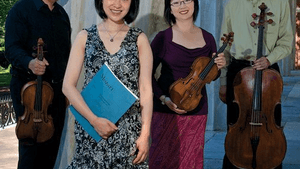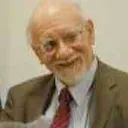Stay in the Loop
BSR publishes on a weekly schedule, with an email newsletter every Wednesday and Thursday morning. There’s no paywall, and subscribing is always free.
May brings new growth in Philadelphia's chamber music scene
Tom Purdom recaps his favorite chamber music premieres

Critics frequently complain that classical music concert halls have become museums, presenting the same works over and over. Anybody who follows chamber music in Philadelphia knows that’s an outdated lament. The chamber music season includes a steady stream of premieres, and it ended this year with a flurry of premieres and newish pieces. I managed to hear most of them, including two of the three premieres penned by Philadelphia composers. They all have their virtues, but four stick in my mind.
The two that had the biggest impact on me were a string quartet by the Finnish composer Kaija Saariaho and a quartet for piano and string trio by Philadelphia’s Jan Krzywicki.
Saariaho’s 2006 quartet is one of those pieces that make me feel like I’m listening to a movie soundtrack. That may sound like a criticism, but it’s not. Movie music is supposed to evoke emotions and Saariaho wrote her quartet with a specific group of feelings in mind. Her notes on the piece say her theme is the way “we continue remembering the people who are no longer with us.”
Chaos and composure
The quartet would seem totally chaotic if you didn’t know that. The moods come at you at random, the way feelings and memories flit through our minds in real life. One moment you’re thinking about something pleasant, the next you’re yielding to a spasm of regret. Sometimes Saariaho hits you with two or three emotions at once, as our memories often do.
Jan Krzywicki’s quartet is just as emotional, but it’s more organized musically. The first movement begins with detached fragments and soon turns into something cohesive and dramatic. The second movement pastorale is a beautiful interlude with glistening piano effects. The fourth movement closes the quartet with a long whirlwind at the end.
Overall, Krzywicki left me with the same feeling I get from Beethoven’s late quartets — the sense that you’re in direct contact with the composer’s state of mind. Krzywicki’s feelings aren’t as conflicted as Beethoven’s but they’re just as real.
The other two items on my personal Top Four list were examples of pure music. Both pieces include music that’s beautiful and inventive but they don’t touch the emotional depths reached in the Saariaho and the Krzywicki.
New combinations for new music
Pierre Jalbert’s String Theory was composed for the East Coast Chamber Orchestra (ECCO), and it experiments with the possibilities created by a conductorless string orchestra staffed by enterprising freelancers and chamber musicians. Andrea Clearfield’s Sagitta takes its title from a word with two meanings; sagitta is the faint constellation the Greeks saw as an arrow and the geometric term for the height of an arc. As the title indicates, it alternates arcing passages with interludes that pursue a straight line like an arrow.
Andrea Clearfield had a great advantage in that her premiere was played by flutist Mimi Stillman and a first rate guitarist, Gideon Whitehead. Krzywicki profited from the presence of pianist Natalie Zhu. Stillman and Zhu play with so much skill and artistry composers can be confident their pieces will receive a premiere that shows them in their best light.
The other musicians responsible for the Krzywicki all played at the same high level. The Clarosa Quartet is a new chamber ensemble composed of two married couples based in Philadelphia. Violinist Juliette Kang is the associate concertmaster of the Philadelphia Orchestra; her husband, cellist Thomas Kraine, is the cellist of the Daedalus Quartet, a member of ECCO, and a busy recitalist and composer. Natalie Zhu’s husband, violist Che-Hung Chen, is a member of the Philadelphia Orchestra and a familiar face to anyone who follows chamber music in Philadelphia.
Chamber music fans should be pleased the two couples form a natural piano quartet (as the piano-and-string-trio combination is called in the somewhat misleading terminology favored by the chamber music world). The piano quartet literature includes some of the masterworks of the chamber music repertoire, but it doesn’t get played as much as works for other combinations. When string quartets add a guest pianist to a program, they usually play a piano quintet and join the piano to the whole quartet. A piano quartet of this caliber should win a regular spot on the Philadelphia Chamber Music Society calendar, which is currently dominated by string quartets.
What, When, Where
Philadelphia Chamber Music Society, Musicians from Marlboro III: Saariaho, Terra Memoria for string quartet. Francisco Fullana, Joseph Lin, violins; Pei-Ling Lin; viola; Jay Campbell, cello. May 5, 2016 at the Perelman Theater, Kimmel Center for the Performing Arts, Broad and Spruce Sts., Philadelphia. (215) 569-8080 or pcmsconcerts.org.
Philadelphia Chamber Music Society, ECCO: Jalbert, String Theory. East Coast Chamber Orchestra. May 13, 2016 at the Perelman Theater. Kimmel Center for the Performing Arts, Broad and Spruce Sts., Philadelphia. (215) 569-8080 or pcmsconcerts.org.
Philadelphia Chamber Music Society, Clarosa Quartet: Krzywicki, Quartet for Piano and Strings. Clarosa Quartet, Juliette Kang, violin. Che-Hung Chen, viola. Thomas Kraine, cello, Natalie Zhu piano. May 15, 2016 at Benjamin Franklin Hall, American Philosophical Society, 427 Chestnut Street Philadelphia. (215) 569-8080 or pcmsconcerts.org.
Dolce Suono: Clearfield, "Sagitta." Mimi Stillman, flute; Gideon Whitehead, guitar. May 17, 2016 at Gould Rehearsal Hall, Lenfest Hall, Curtis Institute of Music, 1616 Locust Street, Philadelphia. (267) 252-1803 or dolcesuono.com.
Sign up for our newsletter
All of the week's new articles, all in one place. Sign up for the free weekly BSR newsletters, and don't miss a conversation.

 Tom Purdom
Tom Purdom